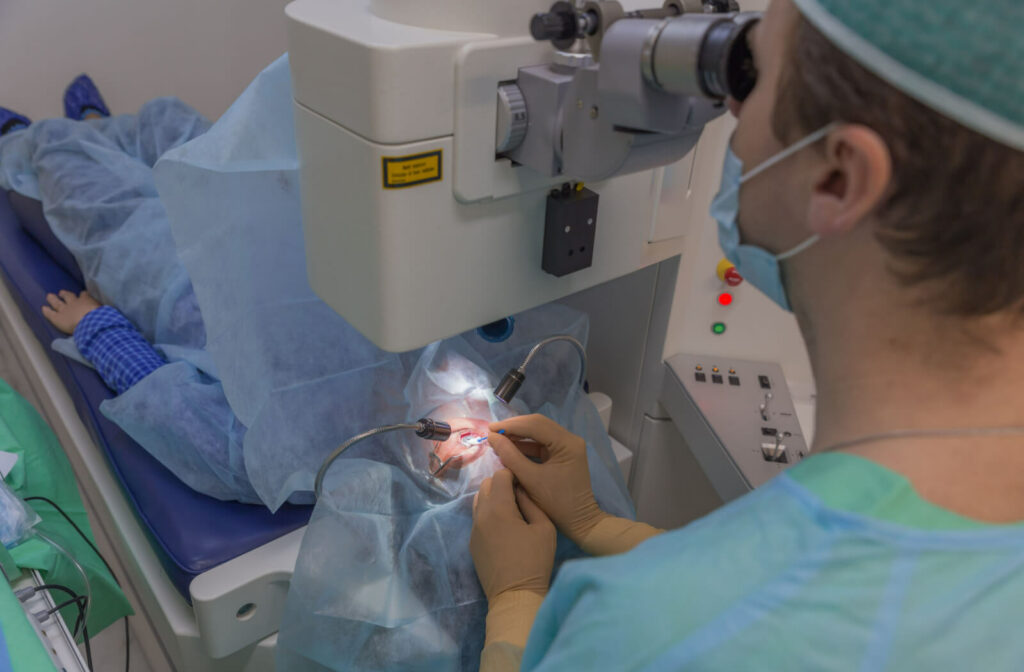What to Expect During Cataract Surgery
Cataracts develop over time, gradually decreasing vision. Eventually, you may need an alternative to glasses or contact lenses, as the later stages can result in blindness. When an ophthalmologist (eye surgeon) determines you’re a good candidate, laser cataract surgery can help restore your vision.
Cataract surgery is an outpatient procedure—meaning patients can return home the same day. It also means patients stay awake during the entire process.
For most of the procedure, you’ll see very little. You can still see light and color, but you won’t see the surgery in detail. Keep reading to learn more about what to expect during the procedure.
What Are Cataracts?
Your natural lens is a clear, curved structure made of 60% proteins. It’s flexible and stretches or shrinks to focus light on the retina (the light-detecting tissue at the back of your eye).
Multiple eye structures help control how much light your eye lets in, including the cornea and pupil. But the lens controls light once it’s inside.
Cataracts develop when the proteins inside the lens break down and clump together. The clumps form spots or flaws, causing the lens to become rigid and cloudy. These spots usually start small, like a smudge on a window. The tiny, thinner clumps can cause minor symptoms, but they can grow to impair your vision significantly.
Symptoms of cataracts include:
- Blurry or foggy vision
- Colors appearing faded or yellow
- Difficulty seeing in dim light
- Light sensitivity & glare
- Double vision
What Is Cataract Surgery?
Cataract surgery removes the eye’s natural lens and its cataracts and also eliminates the possibility of developing future cataracts. Your natural lens is replaced with an artificial intraocular lens (IOL) implant. This replacement lens improves your eye’s ability to focus light.
There are multiple IOL types, such as:
- Accommodative lenses—change shape to focus at various distances (similar to a natural lens).
- Multifocal lenses—zones in the lens help improve vision at multiple distances, such as an upper zone for distance viewing and a lower zone for close vision.
- Toric lenses—correct astigmatism (caused by uneven curves in the cornea or lens).
The Procedure: Step by Step
Cataracts usually develop in both eyes, and each eye will be treated separately if you have cataracts in both eyes. The surgeries will be scheduled one week apart, allowing time for the first eye to heal.
There are a few cataract surgery methods, which means the procedure steps can vary. At Lake Eye Associates, we perform laser cataract surgery. The entire process can take as little as 10 minutes to complete.
Here are the basic steps you can expect during laser cataract surgery:
- Before the surgery, your eyes are numbed with A local anesthetic (usually eye drops or an injection). In some cases, you may be offered a sedative to help you relax.
- You will be awake during the surgery, but you will not see what the surgeon is doing. You may notice movement or shapes.
- Your surgeon will look through a microscope and use a laser to create a tiny incision in the lens capsule (the tissue holding the lens fibers). Next, the laser dissolves the lens fibers into small pieces, making them easier to remove.
- A foldable lens implant is inserted through the small incision and positioned inside the lens capsule. The eye tissue is self-healing, so stitches usually aren’t needed to close the incision.
- After the procedure, you’ll rest in a recovery area for about 15–30 minutes, then you can go home. An eye shield will be provided to protect your eyes while you sleep at night. The eye shield should be worn for one week after surgery.
After Your Surgery
Your surgeon or surgical team can provide more in-depth information about aftercare and when you should schedule a follow-up appointment.
Most people return to regular activity within 1–2 days if there are no complications. However, you should avoid some activities, like rigorous workouts, swimming, or lifting heavy objects.
It’s normal to experience blurry vision in the days following your surgery. It can take up to a month to recover, but most patients notice significant improvement within the first several days.
You’ll be given eye drops to reduce the risk of complications and prevent infections. You should notice your discomfort and symptoms improve over time, but contact your surgical team if there’s no improvement or your symptoms seem to worsen.
Is Cataract Surgery Right for You?
Cataract surgery can benefit many patients whose life has been affected by cataracts. Still, you may want to know if it’s right for you.
It’s okay to be nervous about eye surgery. It’s a major commitment, and we want to help you prepare. Talk to one of our eye doctors to learn about the procedure and what you can expect, from how it’ll feel and look to what you’ll experience after. Book an appointment with our team at Lake Eye Associates today to discuss your vision.

